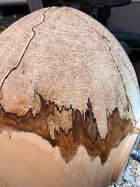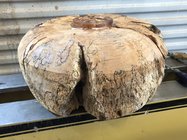-
July 2025 Turning Challenge: Turn a Multi-axis Weed Pot! (click here for details) -
Congratulations to James Seyfried for "NE Red Oak II" being selected as Turning of the Week for July 21, 2025 (click here for details) -
Welcome new registering member. Your username must be your real First and Last name (for example: John Doe). "Screen names" and "handles" are not allowed and your registration will be deleted if you don't use your real name. Also, do not use all caps nor all lower case.
You are using an out of date browser. It may not display this or other websites correctly.
You should upgrade or use an alternative browser.
You should upgrade or use an alternative browser.
too far gone?
- Thread starter Karl Best
- Start date
Well, if you have a 600 or 1000 grit wheel, get the surface damp but not wet, some times that tear out will come out. I don't mess with pieces like that.
robo hippy
robo hippy
That piece looks hazardous!It’s absolutely salvageable. It just depends on how much time/effort you want to put into it. You can soak it with diluted epoxy, or wood hardener, or thin CA. The woodturning purists might argue that you’re just turning plastic, though!
View attachment 58275
That punky wood has a crack from the pith to within inches of the center. That is a blowup waiting to happen. If the wood was sound you might get away with that crack, but super risky in punky wood. The punky issue is not the problem.
That piece looks hazardous!
It certainly could be classified that way. In reference to another thread, I suppose that’s my niche…. I turn wood no one else would or could turn.
There’s a process to turning the worst kinds of wood without taking a shot to the noggin, but I can save almost anything. It just depends whether the piece is worth the effort for me and/or the buyer.
I would never recommend for anyone to turn the garbage wood that I turn, but I would (almost) never say something is unsalvageable.
Just know your limits… and wear proper gear. I’ve actually had to turn pieces with all my motorcycle gear on for fear I’d get tagged by something serious. It’s not for the faint of heart….
Safety third!
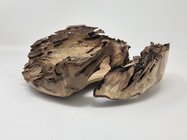
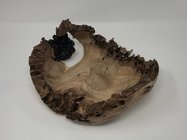
- Joined
- Dec 23, 2015
- Messages
- 64
- Likes
- 173
- Location
- Ringgold, Georgia
- Website
- www.rickurbanwoodturner.com
@Karl Best,
I used to turn stuff like that! It looks like you could easily put your thumb nail deep into the surface. (one of the guidelinse some use to decide if it is too punky)
If you pursue this piece you will most likely spend a great deal of time trying to achieve the result you want and never get there. Even if you completely stabilize it with product x, y, or z, you will likely not be able to get beyond a surface that may feel plastic smooth but will certainly have a punky visual texture. If it is clearly not in danger of blowing up, you may wish to pursue it just to convince yourself, once and for all, that life really is too short to turn something that far gone.
I used to turn stuff like that! It looks like you could easily put your thumb nail deep into the surface. (one of the guidelinse some use to decide if it is too punky)
If you pursue this piece you will most likely spend a great deal of time trying to achieve the result you want and never get there. Even if you completely stabilize it with product x, y, or z, you will likely not be able to get beyond a surface that may feel plastic smooth but will certainly have a punky visual texture. If it is clearly not in danger of blowing up, you may wish to pursue it just to convince yourself, once and for all, that life really is too short to turn something that far gone.
I love wood like that. I use Minwax wood conditioner alot, just received, or will be for xmas, a vacuum pot and cactus juice to hopefully help me with punky wood. I also sharpen my gouges quite a bit, take very small shavings and go very slow. I use alot of CA too on those with small/tight cracks. In the end, I do leave them a little thicker than planned and use a lot of sandpaper. I do keep a small spray bottle of water/dawn to wet down small areas of tear-out. Again, slow... then slower just incase, stay the heck out of the line of fire. I do have them blow apart so I'm looking for better methods. I admit to being a rookie so take my info with a grain of salt, ymmv.
I turn a lot of spalted wood and don't think that piece should be thrown out.
For your particular piece, it is hard to tell how bad the cracks are from the picture. But from what I can see I would do this:
Pump thin CA into the cracks, may take more than one time to stabilize enough to rough turn.
Rough turn to shape, including hollowing out the bowl. Leave it at around 10% wall thickness of diameter. Stay out of the line of fire.
Then use low viscosity epoxy and paint the spalted areas several times till the epoxy does not soak in much.
I use this epoxy:
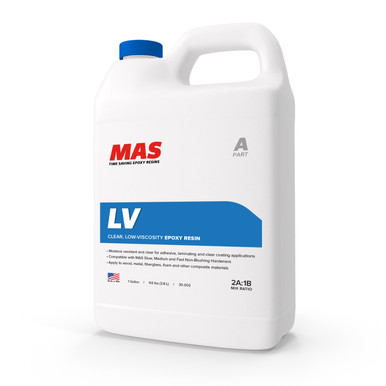
 masepoxies.com
with this catalyst:
masepoxies.com
with this catalyst:
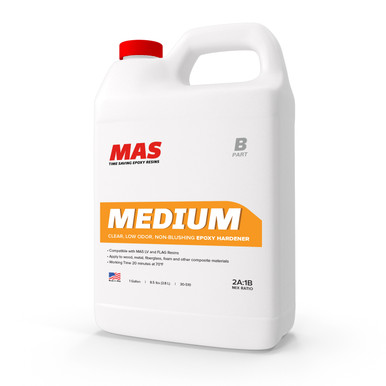
 masepoxies.com
masepoxies.com
It you don't have low viscosity epoxy you can thin it with DNA but I would not use more than 10% DNA as it effects the cure and strength.
For your particular piece, it is hard to tell how bad the cracks are from the picture. But from what I can see I would do this:
Pump thin CA into the cracks, may take more than one time to stabilize enough to rough turn.
Rough turn to shape, including hollowing out the bowl. Leave it at around 10% wall thickness of diameter. Stay out of the line of fire.
Then use low viscosity epoxy and paint the spalted areas several times till the epoxy does not soak in much.
I use this epoxy:

Low Viscosity LV Epoxy Resin
Low Viscosity Epoxy Resin is the original wood epoxy resin. It is clear and enhances the natural beauty and strength of your wooden boat or project.

Non-Blushing Medium Hardener
This is the happy medium of non-blushing hardeners, offering a 3 hour working time.
It you don't have low viscosity epoxy you can thin it with DNA but I would not use more than 10% DNA as it effects the cure and strength.

